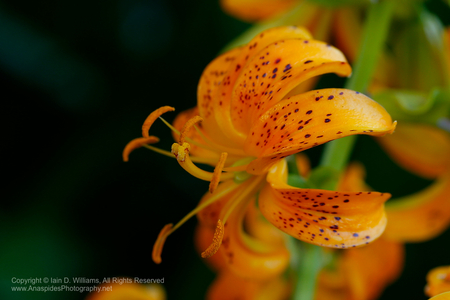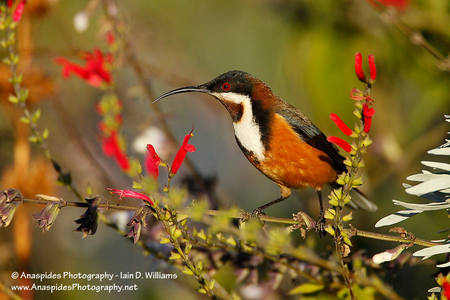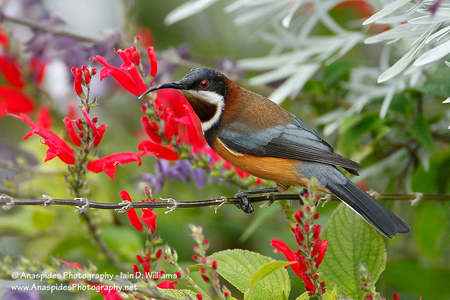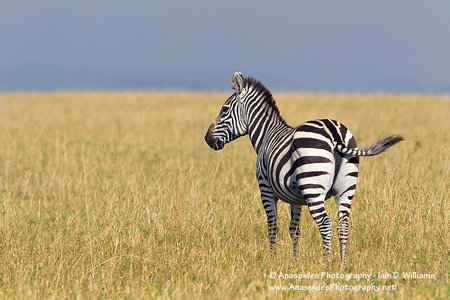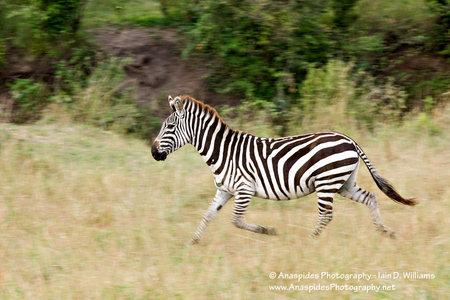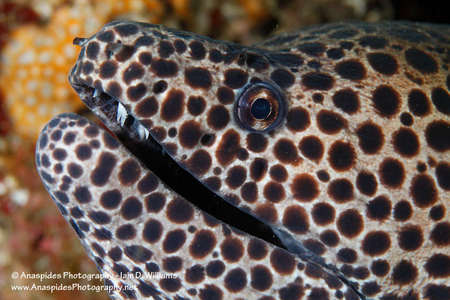 Morays eels may look fearsome and no doubt have intimated more than a handful of divers and snorkelers; however, to say they were dangerous animals would be misnomer.
Morays eels may look fearsome and no doubt have intimated more than a handful of divers and snorkelers; however, to say they were dangerous animals would be misnomer.
LEFT: Black-spotted Moray Eel, (Gymnothorax favagineus). A large eel that reaches 2 meters in length, Indonesia (click image to enlarge).
Moray eels belong to the family Muraenidae and are cosmopolitan, meaning they inhabit tropical and sub-tropical seas globally. Despite their snake-like appearance, moray eels are not reptiles but are fish that have evolved to inhabit a different niche to other fish species. Morays are often the dominant predators within a community.
There are approximately 200 different species of moray eel that range in size from a few centimetres to 2 meters in length. They have adapted well to their niche and most morays sport large eyes which enhance their light-resolving ability when hunting in crevices, caves, and at night.
Moray eels have a narrow head, an elongated body which is slightly flattened towards the tail, and a lack of pectoral and anal fins leads to their serpentine appearance. Their jaws are normally large with sharp incisory teeth. The teeth of animal are usually a very good indicator to the prey it selectively hunts.
Moray eels are carnivores and the moray’s pointy teeth are ideal for capturing fish, crustaceans, molluscs and even other eels. Although for the most part solitary, morays have been known to co-operate with other species such as cod, grouper, sharks and even ingenious spear fisherman to obtain food.
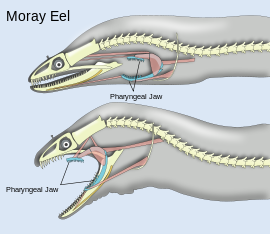 Pharyngeal Jaws
Pharyngeal Jaws
An interesting evolution observed in moray eels are pharyngeal jaws . Simply explained, morays have a second set of jaws in their throat that contain teeth. When feeding these inner jaws can be projected into their mouth cavity whereby they grasp the prey and dislodge flesh before transporting the food into the back of throat and into the digestive system.
LEFT: Diagram showing pharyngeal jaws in moray eel. Moray eels are the only animals that use pharyngeal jaws to actively capture and restrain prey (diagram copyright).
Once the prey has been seized, the eel twisted onto itself to remove a bite-sized portion of food. A moray eel does not have the ability to chew its food and swallow as do other fish. Because of the narrow head, it is unable to create negative pressure used to swallow prey. The pharyngeal jaws are therefore very important.
Skin
Unlike other fish, morays do not have scales. To protect their skin they secrete a slimy mucus. In some species the mucous contains toxins which provide self-defensive against other animals that may prey on the eel. The slimy skin aids in locomotion (slithering into and out tight locations), makes it difficult for a predator to grasp the eel and, in some species assists in burrow-building. Ribbon eels (Rhinomuraena quaesita) often live in sand burrows and the mucous is used to cement sand grains together to provide a solid wall for the burrow.
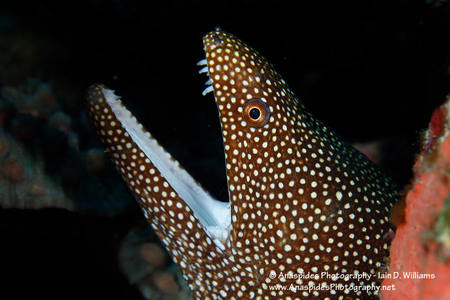 Reproduction
Reproduction
Interestingly moray eels are not live-bearing but are oviparous, which means that sperm and eggs are fertilized outside of the womb in the surrounding water.
When morays spawn they release thousands of eggs which can develop into larvae which become part of the plankton that drift in the ocean currents. After a year or so, the larvae mature and can swim the sea floor to join whatever community that maybe living there.
LEFT: Whitemouth Moray Eel, (Gymnothorax meleagris). An uncommon eel observed in Indonesia (click image to enlarge).
Undeserved Reputation
Their fearsome reputation (which is unwarranted) has been generated from the method they use to breathe (removing oxygen from seawater). A moray must continually open and close its mouth to generate a current of water that is passed over small circular gills which are located toward the rear of the mouth.
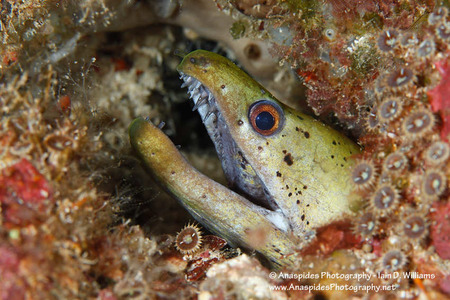 Moray eels are not aggressive and if treated with respect will not attack a diver. However, if you wave your gloved-finger in front of their face then expect a reaction – not because it’s a finger but because the waving action and colour resembles a small fish.
Moray eels are not aggressive and if treated with respect will not attack a diver. However, if you wave your gloved-finger in front of their face then expect a reaction – not because it’s a finger but because the waving action and colour resembles a small fish.
LEFT: Fimbriated Moray Eel, (Gymnothorax fimbriatus). An eel not observed that often (click image to enlarge). Photographically, morays are of interest due to their morphology, differing camouflage patterns and often kaleidoscope of colours.
I can recall a dive in Japan when I was foolish enough to wave a non-gloved finger in front of a smallish, but brightly coloured dragon eel. The result was not unexpected; the eel removed a large chuck of flesh from the side of my index finger.
I always keep a lookout for these fascinating creatures when diving, and if I see a moray, I stop and observe its behaviour and marvel at its evolution and often ornate and colourful markings.
 Tuesday, January 14, 2020 at 9:39PM
Tuesday, January 14, 2020 at 9:39PM 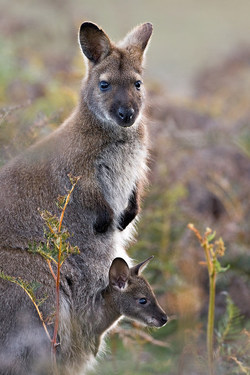 "Our Homes Are GONE" It's as simple as that...
"Our Homes Are GONE" It's as simple as that... 


